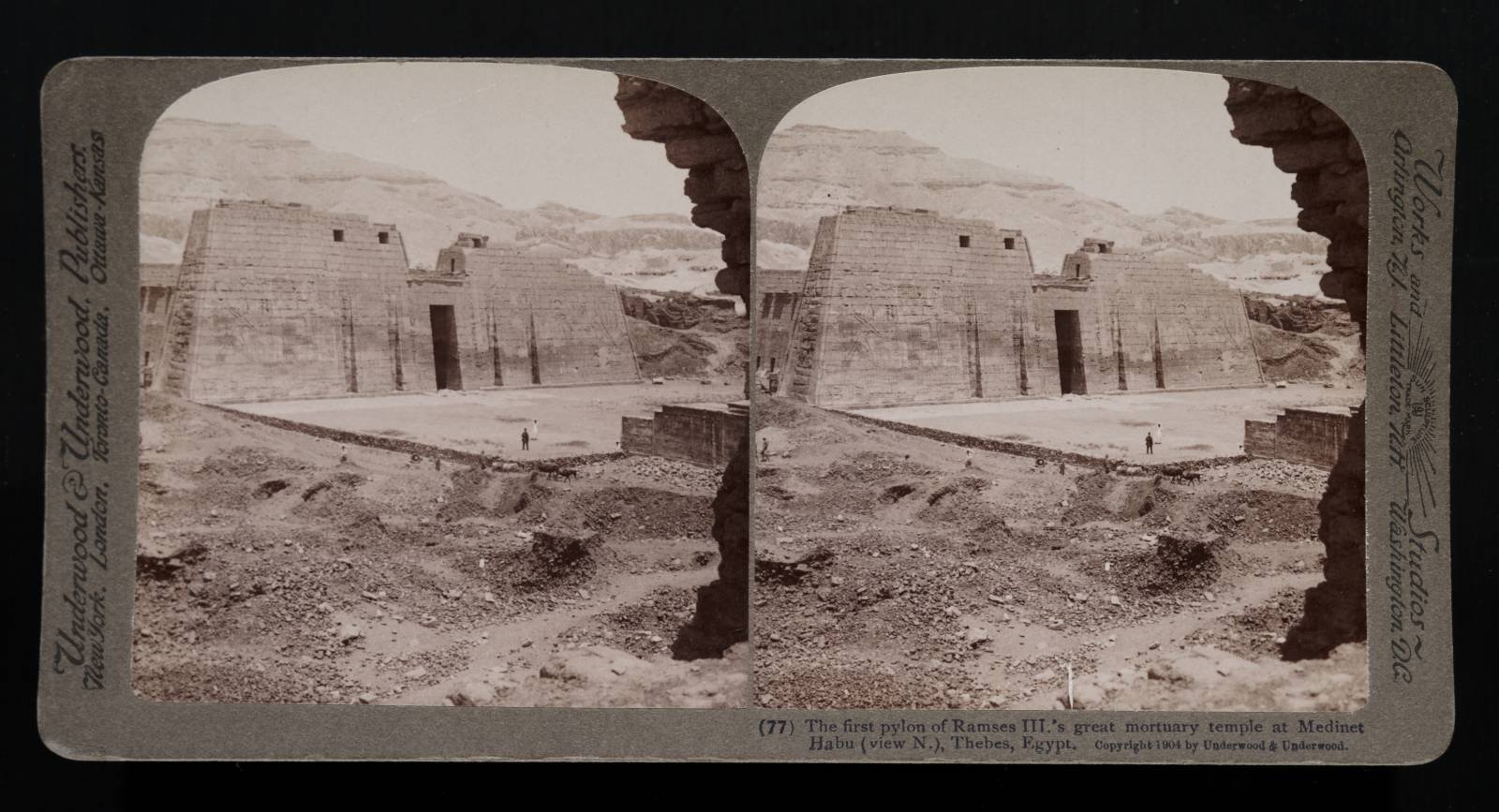Egypt Through The Stereoscope
A Journey Through The Land Of The Pharaohs
by James Henry Breasted | 1908 | 103,705 words
Examines how stereographs were used as a means of virtual travel. Focuses on James Henry Breasted's "Egypt through the Stereoscope" (1905, 1908). Provides context for resources in the Travelers in the Middle East Archive (TIMEA). Part 3 of a 4 part course called "History through the Stereoscope."...
Position 77 - The First Pylon Of Ramses Iii's Great Mortuary Temple At Medient Habu (view North), Thebes
 This is the best-preserved temple which we have yet seen. We shall meet only two more so perfectly preserved as this—the Edfu temple and the temple of Philae, which are still before us; but we may compare the Denderah temple, also a remarkably perfect structure, which we have already visited. This temple faces almost exactly southeast, so that as we here look obliquely across the front we are facing almost due north (Plan 15).
This is the best-preserved temple which we have yet seen. We shall meet only two more so perfectly preserved as this—the Edfu temple and the temple of Philae, which are still before us; but we may compare the Denderah temple, also a remarkably perfect structure, which we have already visited. This temple faces almost exactly southeast, so that as we here look obliquely across the front we are facing almost due north (Plan 15).
On our right is the southern end of the western plain, beyond which are Luxor and the river (Maps 8 and 9). Before us in a line just outside the extreme right of our field of vision, extends the row of western temples, from the latest here, through the 18th Dynasty in the middle, to Kurna, and its temple of Sethos I at the extreme north.
The southern slope of Shekh Abd el-Kurna rises between the pylon and these rough brick, which frame in our field close on the right, but the latter prevent us from seeing the place where we stood as we looked down upon this temple (Position 68). It is further to the right than those tomb openings which you observe in the face of the cliff. The pylon before us was once closed by the palace “outer court,” of which this wall, on which we are now standing, was the front.
The Pavilion forming the entrance to the palace is on the right, now out of range, but in line with this brick wall beneath our feet, which you will be able to locate on the plan (No. 15). The pylon shows the panels for the reception of the tall flagstaves, as we have seen them before, but the colossal statues of the king, which usually rise before the pylon, are missing. The pylon itself bears two symmetrical representations, one on the front of each tower, outside of the panels. There in relief we see the king slaying his captives before Amon, in a scene exactly like that of Shishak, which we visited at Karnak.
The god presents to King Ramses III a list of cities and countries, which covers the whole front of the pylon below them, and embraces almost all such names known to the Egyptians, which the accommodating scribe, who put together the list for the king, copied from the similar lists which he found at Karnak, without stopping to inquire whether the king had ever really campaigned in those countries. Perhaps we must pardon the unlimited mendacity of this list, when we recollect that this temple is a chronological record of the reign of this king, which contains some of the most severe wars through which Egypt ever passed, wars in which the king won himself a name and fame which he quite deserved.
Few kings have put so much upon temple walls as Ramses III. Those in the rear of the temple, which we cannot see from here, contain records of his great war with the Libyans in his fifth year; that is the oldest part of the temple. In the middle we find the accounts of his dangerous war with the sea peoples of the north, which we shall later view, and finally the front and back of this first pylon bear the records of his second Libyan war in his twelfth year.
Thus, as his temple grew from rear to front, the king was always passing through or had just concluded some great war which found place on the walls. As the architecture of the temple cannot be compared with the beautiful creations of the 18th Dynasty, we shall not spend any time on the courts and halls, but shall examine some of the more interesting reliefs.
Those on this side of the temple, on the outside of the wall, behind the first pylon, are devoted to the peaceful pursuits and religious duties of the king, while those on the other, or corresponding, side are records of the king's wars. On the back of the pylon, where it projects beyond the side wall, here at the left is a wild bull hunt, which is well worth our inspection, and to this scene we shall first go. See red lines numbered 78 on our Plan 15.
